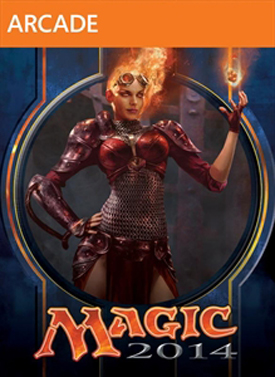
Magic 2014 – Duels of the Planeswalkers
Developer: Wizards of the Coast/Stainless Games
Publisher: Wizards of the Coast
Platforms: Xbox 360 (Reviewed), Playstation 3, iPad, Android, PC
Release Date: Out Now
Price: 800MSP or $9.99, Available on XBLA/Steam/iOS/Google Play/Amazon Store/PSN (Coming Soon)
Overview
Magic 2014 is is the latest installment in the Duels of the Planeswalkers franchise. It offers players of all experience levels a chance to play Magic at a relatively low cost. Retaining the staples of what makes the card game and its digital brethren so special, and adding new features that were previously unseen in the Planeswalkers franchise makes for a game that should not be passed up by anyone who is into Magic or looking to get started.
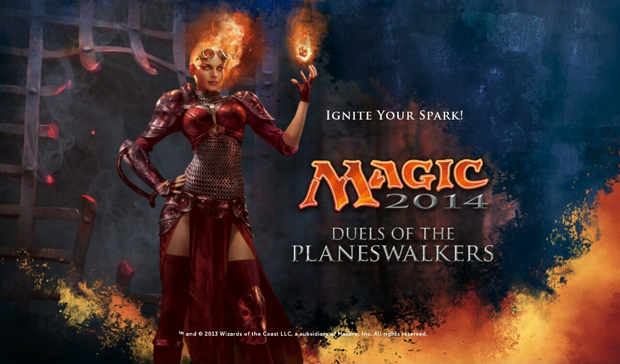
Story
Magic has always been filled with great stories. From the novels, to the approach to the way cards are designed; from the “flavour text” at the bottom of many cards and even the matches themselves. Magic is a world of stories. Sadly, in previous iterations of the Planeswalkers series, these stories haven’t been featured. Magic 2014 rectifies that injustice, and gives players a solid storyline to fill in the gaps between matches that comprise the game’s moderately-lengthed campaign.
You play the role of a Planeswalker (as in the card game) who has to help a radical young pyromancer Chandra Nalaar (another Planeswalker) who has been betrayed by someone she trusted. The two of you must travel between the realms to track down this foe and bring him to justice.
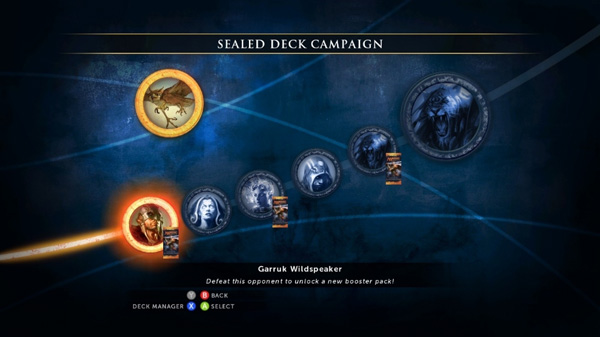
The game’s story is well told through fully animated cut-scenes, and Chandra’s voice offering you guidance and important information about where you are and the key features of the realms. The story in the end doesn’t serve as much more than a way to tie together the string of encounters and traditional MTG matches, but it is good to see such a key aspect of the franchise no longer being overlooked.
Gameplay
Duels of the Planeswalkers is a faithful recreation of the ever-loved Magic the Gathering TCG, complete with instants, sorceries, creatures, enchantments, land and Planeswalkers. If you don’t know what any of that means then don’t worry, Duels of the Planeswalkers might still be for you. The game offers a nice little tutorial that allows players of all experience levels to learn the ropes and catch up on any rule changes that might have been implemented since they last played.
Magic 2013 didn’t offer much to shake up the franchise, and there were understandable fears about the Planeswalkers games getting stale. 2014 has knocked away those fears by adding a slew of new content and game modes to please Magic fans everywhere. Not only are there ten more decks you can unlock, use and customise, but the Sliver archetype has finally made its digital debut (for those who don’t know, Slivers all share their abilities with one another – so if you have two or three out on the field, then you already have a destructive force at your command).

Taking away all the extra cards and deck possibilities (which given the nature of the game are expected inclusions), what is probably the most exciting addition is Sealed-Deck Play. Sealed-Deck Magic is a staple of many tournament-circles, and involves each player opening a booster pack, picking out a card, then passing the rest along. The result is that everyone creates a deck right there on the spot out of a random set of cards. In real-life it takes away some of the cost-barriers to Magic and makes the game even and fair. It is also a lot of fun, and forces people to think up new strategies on the fly. It translates well across to Planeswalkers, where you can play a Sealed-Deck Campaign against the AI, or online against other players.
Magic 2014 is plain and simply just Magic. It uses the same rulebook, and the same regulations. It does this fine enough, and would be a perfect recreation of the game if not for a few technical problems. Firstly the game runs very slowly, and you are forced to pause the game in order to perform most actions. It isn’t a huge problem to pause the game to interrupt an opponent’s actions, but the lack of speed at which this is all executed is a real downer on gameplay.
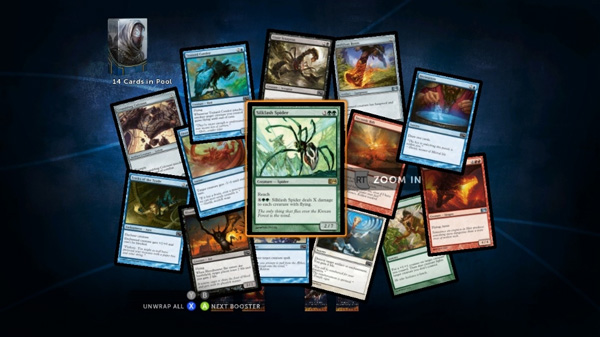
The game’s menu’s are another area where the game struggles – there is a noticeable amount of input lag when navigating the game’s menu’s, often resulting in you selecting options that you didn’t plan on, or accidentally restarting the match where you just wanted to tweak the sound settings. On its own it isn’t enough to detract from the gameplay experience, but when you couple it with the slow and sluggish response times in-game, an annoying pattern begins to rear its ugly head.
The controls however are all quite nice, and the way they are mapped out makes it possible to play entire matches with only one hand. While this doesn’t serve much of a purpose in the grand scheme of things, it does make it possible to eat a piece of fruit and play Magic at the same time.
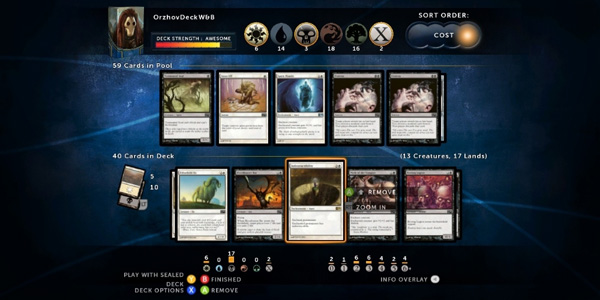
Visuals
Magic’s card art has always been a standout feature of the game, with the best artists in the business lending their talents to design creatures and give life to the worlds. As art is the soul of Magic the Gathering, it is only fitting that it is transferred across perfectly, and no detail has been lost in the translation. Comparing real cards to their digital counterparts shows that everything has been meticulously recreated.
The downside to the game’s visuals is that outside of the cut-scenes, there isn’t anything new offered in the game. The backdrops of locals and the enemies you face are all taken directly from the cards themselves. It doesn’t detract from the game all that much, but it would be nice to see some new stuff thrown in there to really make this game unique.
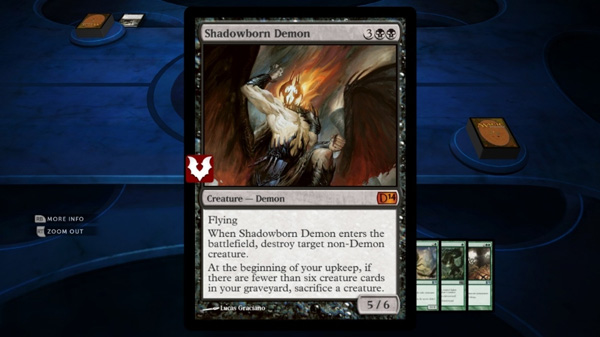
Some of the more note-worthy creatures have animations that play when they are first cast. these animations really pop and although they don’t last very long, really do give a sense of these creature’s esteem. When creatures attack or when some particular instants or sorceries are cast, the game will make visual or audio cues depending on what the card is, or what it does (for Example: Overrun makes green tendrils stretch across the battlefield while the sounds of the rumbling earth is played in the background). These are fun, but if you are trying to focus on the game at hand, can go largely unnoticed.
Audio
Although the game has sound effects that add their own unique life to the battlefield, they can sometimes be a little too much. Hearing the same sound every time you play Overrun gets tiresome, especially as the game halts while the sound and animation runs their course. If these were used a little more sparingly they would have a greater impact on the game (such as playing when a certain spell will change the tide of the battle). The soundtrack however is stellar and close to perfection for this type of game. It offers ambient music to the game that serves to pump you up and keep you focused, while remaining unobtrusive.
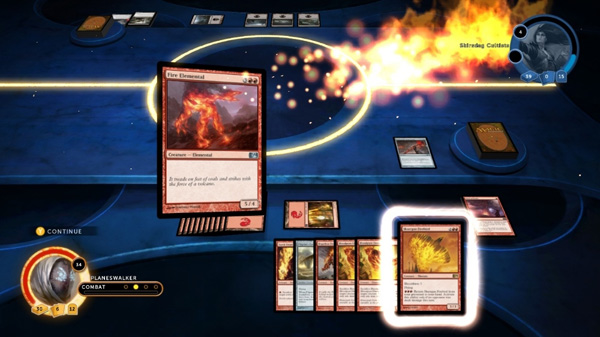
Overall
Magic 2014 takes the staples of its predecessors and adds enough new content to make for a worthwhile purchase. As a bonus, the game also offers the first-look at many of the cards that will be appearing in this year’s 2014 Core Set. Whether you are a Magic veteran, or just looking to start out, Magic 2014 offers a worthwhile experience for you. Its few nagging technical issues hold it back from being the definitive digital Magic the Gathering experience, but there is still plenty here to like, especially since the whole game is only the price of a booster pack.

Capsule Computers review guidelines can be found here.

